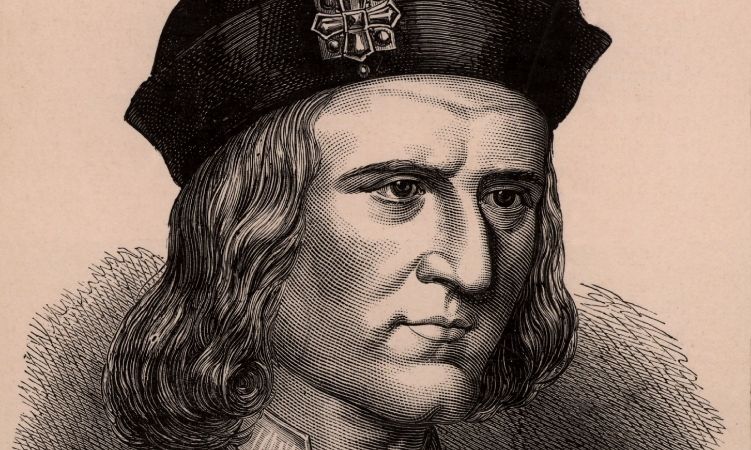To build your own Itinerary, click  to add an item to your Itinerary basket.
to add an item to your Itinerary basket.
Already saved an Itinerary?



You are here: UK History > Royal History > House of York > Richard III | The final Yorkist king
Not only was Richard III the final York king to sit on the throne but was also the last of England’s Plantagenet kings. As the youngest son, Richard was never considered in the line of succession and yet has become one of the most divisive and talked about kings in history.
Born: 2nd October 1452, Fotheringhay Castle, Northamptonshire
Died: 22nd August 1485 (aged 32), Bosworth Field, Leicestershire
Reign: 26th June 1483 – 22nd August 1485
Parents: Richard, Duke of York and Cecily Neville
Predecessor: Edward V (nephew)
Successor: Henry VII (cousin)
Spouse: Anne Neville (1472-1485)
Children: Edward of Middleham and also John of Gloucester and Katherine, both illigitimate.
Royal House: Plantagenet, York branch
Richard was born at Fotheringhay Castle in Northamptonshire and was the youngest son of Richard, the Duke of York and Cecily Neville. He was well born and well connected, part of the extended royal family and the son of a respected Duke. His older brother Edward would become Edward IV after defeating Henry VI in the War of the Roses, which would further propel Richard into a life of grandeur and power.

Image: Richard III
As a child, Richard's father was initially the governor of Normandy before relocating the family to Ludlow Castle. A few years later, he was named the Govenor of Ireland and Richard and his siblings found themselves moving around again. In fact, the family moved significantly through Richard's early years.
When the king, Henry VI suffered a bout of mental unwellness, Richard's father stepped in the run the government on his behalf, which resulted in the start of the War of the Roses. After the death of his father and the deposition of Henry, Richard’s older brother Edward became king, making Richard a royal prince. As well as being given a royal title, the Dukedom of Gloucester was created for him and he and his brother George, the Duke of Clarence moved into Greenwich Palace.
Edward IV’s reign was marred with civil war and both he and Henry VI fought and deposed each other twice. As such, Richard couldn’t get too comfortable in any of the royal palaces and for a time, lived with his cousin, Richard Neville, the Earl of Warwick. Neville gained the title Kingmaker because of his influence among the royal family, during the War of the Roses, he worked both for and against the York cause. In one instance, he worked with George, the Duke of Clarence, to return the deposed Henry to the throne. This resulted in Edward losing the throne and fleeing to Flanders. Richard remained loyal to his brother and became his figurehead in Wales, even joining him in exile before fighting alongside him in the Battles of Barnet and Tewkesbury.
During the Battle of Tewkesbury, Edward of Westminster, the only son of Henry VI was killed and many believe that Richard arranged this on behalf of his brother. Henry VI himself died shortly after in captivity, again, something believed to have been orchestrated by Richard, perhaps on Edward’s orders. Edward was returned to the throne around Richard’s 18th birthday and as such, Richard was given a variety of responsibilities as befitting a nobleman of the time. Even so, it was never expected that Richard would ever gain the throne. Edward had ten children, naming his eldest son, also Edward, as his heir and his second born son, Richard, heir apparent. Of course, if that failed, there was one Lancastrian claimant left, Henry Tudor, who was exiled to France.
Historians continue to debate when exactly Richard planned to usurp the throne and why.
He gave the impression that he was loyal to Edward, not only fighting with him but continuing to support him once he had regained the throne. Despite this, he was known to want to start his own dynasty. Contemporaries described him as being someone who would get what he wanted, even if it was at the expense of others. Much of his plans to further himself politically were financed by seizing the property of anyone defeated by his brother and more nefariously, coercing an elderly countess into surrendering her inheritance to him.
Other funds were amassed through his marriage to Anne Neville, the youngest daughter of his cousin, the Earl of Warwick. After the death of her parents, he insisted on being given her share of her inheritance, causing a rift with his brother, the Duke of Clarence, who had married her sister. Between them, the royal brothers (the King, the Duke of Clarence and the Duke of Gloucester) colluded to deprive the Neville sisters of their entitlements. Not content with stealing from his brother, Richard was later involved in a plot to accuse George, the Duke of Clarence of treason. George was found guilty and was executed. Richard benefitted greatly from his death, not only financially but also by gaining influence.
Richard’s character continues to divide opinion, some see him as being callous and ruthless, while others see that he merely manipulated circumstances to do what he deemed to be justified. However you see it, it is true that he gained much more power than originally intended in a short period of time. Edward IV never questioned his loyalty and he was named the king’s lieutenant in the north. There is some evidence that he was in fact so powerful in the region and had been so victorious over the Scottish army, that he could have easily gained the crown there. Instead, he went after the English one. The plan that most defines Richard and his reign is the one implemented on the sudden death of Edward IV. Whether Richard thought what he was doing was just or whether he was hungry for the power will never be confirmed, but what we do know is that on hearing of his brother’s death, Richard made his way across country to meet with his nephew, 12 year old Edward who had been named the new King.
In his will, Edward IV had named his oldest son as his successor and Richard as Lord Protector. Something that was regularly done to bring about stability if a new king was still under age. Being Lord Protector meant you would advise and rule on the new king’s behalf until they were old enough to do so themselves. This position alone would have granted Richard much more power than he had previously experienced but clearly, it wasn’t enough.
Edward V’s household prepared to journey with him from his home at Ludlow Castle to London for his coronation. The head of his household was Anthony Woodville, his maternal uncle and the majority of the travelling party was made up of members of his mother’s family. Although the Woodvilles were suspicious of Richard, he swore allegiance to the new king and so they agreed to meet with him on the road and allow him to accompany him to London. The Woodvilles were concerned that Richard could gain too much power and that Edward would become little more than a puppet and so wanted his coronation to take place immediately, something that would make the role of Lord Protector somewhat obsolete.
Although Richard went along with the plan to move the new king to London, he worked to postpone the coronation repeatedly.
He met with Edward V, Anthony Woodville and Richard Grey, the king’s older half brother, and then the following day, had both Woodville and Grey arrested, stating that they were a danger to the new King. The pair had their lands seized and were sent to Pontefract Castle where they were later executed. Edward was powerless to resist and besides, Richard was his uncle, so clearly had his best interests at heart, right?
Richard assured him that it was all for his own safety, claiming absolute loyalty. He dismissed the rest of Edward’s household and escorted him to London with his own retinue. As he was known to be the Lord Protector, this wasn’t seen as suspicious to the wider population and it wasn’t unheard of for family members to turn against each other, the country had after all been living with the fall out of a civil war for years after all. At this point, although Edward was known to be king, Richard was recognised as head of the government.
Once arriving in London, Richard took his nephew to the Tower of London, which as well as being a prison, was a royal residence and one that was often used prior to a coronation. The young king was kept under armed guard with Richard claiming that this was all for his protection while awaiting coronation. We now know that Richard never intended for Edward to make it to his coronation.
In fact, Edward had the shortest reign of any king, he was never crowned and was deposed just two months after gaining the title. Elizabeth Woodville, Edward’s mother, fled to Westminster Abbey with her remaining children to seek sanctuary once she heard that Richard had Edward in his custody. It wouldn’t be long though before he had another of her children, her youngest son, also Richard, in his grip. The ten year old was the new Duke of York and was heir apparent until his brother married and had children. Richard claimed that he simply wanted to ensure that the prince was at the coronation, but he too went into the Tower.
The next stage of Richard’s plan was to execute Lord Hastings for treason. Hastings was a long term supporter of Edward IV and by extension Edward V, and was one of the voices questioning why the coronation was being delayed. Once Hastings had gone, Richard was the most powerful person in government, allowing him to declare that he was the rightful king, not his nephew. There had been rumours for years that Cecily Neville had been unfaithful, resulting in Edward IV being illegitimate – it was noted that Edward was tall and blonde and their father short and dark. Richard on the other hand did resemble his father. He also floated the idea that his brother’s marriage to Elizabeth Woodville was invalid and in an act of parliament called Titulus Regius, claimed that all ten of his nieces and nephews were illegitimate. Edward’s reign came to an end on 26th June 1483, just two months after his father’s death. The act remained in place until Henry VII repealed it.
Richard was crowned Richard III at Westminster Abbey on 6th July 1483 alongside his wife Anne. Edward V and his younger brother were never seen again.
Richard maintained throughout his reign that he was justified in his actions and that he believed that his nephew was illegitimate because his brother had previously been betrothed to someone else prior to his wedding to Elizabeth Woodville. This fact was never contended at the time of his marriage.
Whether or not Richard did orchestrate the murder of Edward V and Prince Richard has continued to be debated to this day. Richard himself never publicly confirmed or denied that the boys were dead even though theories about what happened to them continued to undermine him. Though it is widely agreed that Richard was the most likely suspect, the Duke of Buckingham and Henry Tudor have also been implicated.
Something that seems to absolve Richard is that he and Elizabeth Woodville came to a truce, he allowed her and her daughters to come out of sanctuary, housing them in royal residences and providing for them. He did also intend to marry his oldest niece Elizabeth of York after the death of his wife Anne. Historians debate whether Elizabeth Woodville would have entertained this idea if she truly believed that Richard had murdered the princes, though he did have Richard Grey executed on false charges, which throws confusion over her own motives. She would later have her daughter married to Henry Tudor, who would usurp the throne from Richard and throughout their marriage would plot against Henry to restore the York line to the throne. Whatever happened to the princes and whatever Elizabeth Woodville’s feelings on the matter, she served as an ally for Richard as during his reign.
On his coronation, Richard presented himself as a reformer, claiming that he was committed to justice and righting the moral wrongs of his brother’s rule. However, he was never fully respected or liked by his subjects. He was deemed to be a murderer, a tyrant and a committer of incest due to his interest in his niece. The fact that he sought to strengthen his claim by marrying Elizabeth of York also led many to view him as a contradiction, if Elizabeth and her siblings were illegitimate, how was she to strengthen his hold on the crown?
Throughout his two year reign, he faced opposition from the rulers of southern England who saw Richard as nothing but a usurper. He was also under constant threat of invasion from France who recognised Henry Tudor as a valid alternative. Though Henry’s claim wasn’t as strong as Richard’s, he was supported by the southern nobles who disliked Richard so much they didn’t care who removed him. Henry Tudor’s claim was via the Beaufort line on his mother’s side, his grandfather was the half brother of Henry VI and he was a descendant of the Welsh Tudors of Penmynydd. Though the Tudors weren’t considered nobles in England, they were a prominent family in Wales.
Richard’s hold on England weakened after the death of his only son in 1448. Several family members attempted to overthrow him and when exiled, headed to France to join Henry Tudor’s campaign. Tudor’s army was made up of French and Scottish mercenaries, as well as some English lords, supported by Baron Thomas Stanley, the Lord High Constable of England, his step father and one of the most powerful men in the country. Tudor and his army invaded in 1485, meeting Richard’s forces at Bosworth Field culminating in one of the most famous battles in English history. Richard was killed in battle and Henry ascended the throne becoming Henry VII, marrying Elizabeth of York and uniting the York and Lancaster houses, ending the War of the Roses.
Centuries later, Richard’s remains were found under a carpark in Leicester. He was the last English king to die in battle and examination of his remains in 2013 showed that he had 11 significant wounds, eight of them to the head, indicating that he had likely lost his helmet during the battle. It is believed that Richard’s naked body was tied to a horse and transported to Leicester before being displayed in a church and then buried in Greyfriers Church, Leicester. Henry VII later paid for a marble monument for Richard, though the exact location of his final resting place was lost to time and development. The Richard III Society, who aim to reassess the king’s reputation commissioned an archaeological dig to recover his grave and identifying him via his DNA. He was reburied in Leicester Cathedral in 2015.
Richard’s character continues to be debated. The Richard III Society say that he has been unfairly represented throughout history. Records show that he was faithful to his wife and that his two known illegitimate children were fathered prior to his marriage. However, following the death of Anne Neville, he was forced to publicly deny that he had poisoned her in order to marry his niece. There is no evidence to suggest that he had an affair with Elizabeth of York. Many contemporary views on Richard were shaped by propaganda from Henry VII’s reign and the plays of Shakespeare that paint Richard as a villain, though peers from the time claim that despite being ruthless in his ambitions, he was pious and promoted legal fairness. However you view him, he remains one of the most divisive kings in history.
Barnard Castle, County Durham
Former home of the Neville family.
Bosworth Battlefield Heritage Centre, Leicestershire
The site of the final battle on English soil and where Richard lost his life and throne to Henry VII.
Crosby Hall, London
While Duke of Gloucester, this was one of Richard's residences.
Fotheringhay Castle, Northamptonshire
Richard's place of birth.
Ludlow Castle, Shropshire
Richard's family home for a time.
Richard III Museum, York
The museum can be found at Monk Bar, in one of the city’s medieval gateways. Monk Bar is the tallest gateway in the city walls. The museum features a chamber built by Richard himself.
Snape Castle Chapel, Yorkshire
Richard owned the site at one point.
Tower of London
Richard had his nephews imprisoned here while he took the throne.
Warwick Castle, Warwick
The castle was at one point granted to Richard when he was Duke of Gloucester.
© Visit Heritage 2025. All Rights Reserved

.png)


